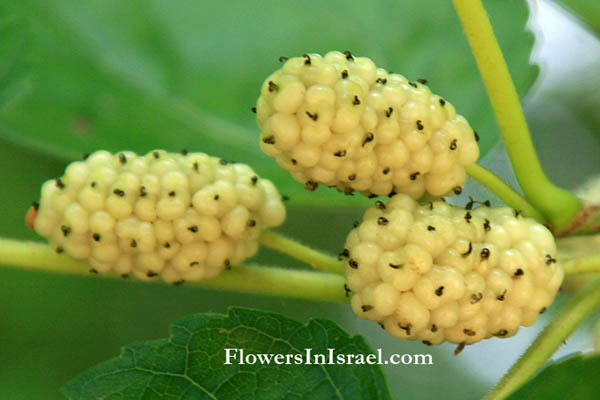Hebrew: תות-עץ, Arabic: توت أبيض
| Scientific name: | Morus alba L. | |
| Common name: | White Mulberry | |
| Hebrew name: | תות לבן, tut lavan | |
| Arabic name: | توت أبيض, tutu 'abyad | |
| Family: | Moraceae, תותיים |

|
| Life form: | Phanerophyte,tree | |
| Stems: | Can reach over 20 m. in height | |
| Leaves: | Alternate, entire, ovate, rounded or cordate at base, dentate or serrate; usually smooth above, glabrous beneath | |
| Inflorescence: | Axillary, pendulous; male flowers in a catkinlike raceme, with lax flowers; female flowers in a long or short spike | |
| Flowers: | Greenish, inconspicuous, with 4 free imbricate petals; male flowers 4 stamens, pistillode top-shaped; female flowers ovary enclosed, 1-(2-) locular with a single ovule, style bipartite | |
| Fruits / pods: | Juicy drupelets; peduncle about as long as syncarp | |
| Flowering Period: | February, March, April | |
| Habitat: | Disturbed habitats | |
| Distribution: | Mediterranean Woodlands and Shrublands | |
| Chorotype: | Med - Irano-Turanian, escaped from cultivation | |
| Summer shedding: | Perennating |

Derivation of the botanical name: Morus, the Latin name for mulberry. alba, white, referring to its leaf-buds. Mulberry from Latin morum + berry, Old English mōrberie. The Heberew name: תות, tut , from Aramaic תותא / ܬܘܬܐ (tūṯā).
The black mulberry, possibly a derative of the white mulberry, grows wild in Northern Iran, on the shores of the Caspian Sea, and in Colchis, an ancient region on the Black Sea south of the Caucasus Mountains (Colchis is where Jason, the legendary leader of Argonauts, traveled in search of the Golden Fleece ( the winged ram Chrysomallos)). Both species, the white and black mulberry, contain in every part a milky juice, which will coagulate into a sort of Indian rubber, and this has been thought to give tenacity to the filament spun by the silkworm. The White mulberry a deciduous fruit tree and is so-named for the color of its buds, rather than the color of its fruit. It is a small tree up to 12 meter tall, branches low and develops a wide spreading crown. The trunk can attain 60 cm in diameter. The leaves of the Morus alba are variously lobed even on the same plant. Some are unlobed while others are glove-shaped. The flowers are small, greenish-yellow, in dense spikes to 2 cm long. The fruit Resembles blackberries, cylindrical, 1 to 1 1/4 inch long, fleshy multiple of drupes. White mulberries can produce white, lavender or black fruit. The fruits are generally very sweet but often lacking in needed tartness. The fruits are ready for harvest in late spring. Fruits may be eaten raw or cooked. Fruits are an ingredient of a particularly seductive drink known as Mulberry Wine. Most of Italy's silk comes from the communities around the northern city of Como, where the white mulberry is raised for this purpose. Pliny, Ovid and Virgil wrote about the mulberry, which was raised on farms throughout the Italian peninsula, but while the Romans associated silk with its leaves, they may not have understood that silk worms actually produced the substance.
The Mulberry is also grown for rearing silk about many of the villages between Jerusalem and Nablous (Shechem) and often covers the terraced hill-sides…" Bible resources:
|